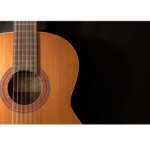Learning basic guitar chords is the first step in learning the guitar. Guitar chords allow you to play songs and create songs. They are the framework to all music. The most essential concept to master while learning chords is transitions. Practice playing each basic guitar chords by changing back and forth from each chord. Today we are going to discuss 4 common chord progressions that every beginner should learn on the instrument.
We will be learning a the following types of chord progressions:
- C-F-G
- I-V-Vi-IV
- I-Vi-IV-V
Lets dig into some of these basic guitar chords and progressions. Learning this chord progression patterns will help you get on the right track.
Basic Guitar Chords: C major,F major,G major
In this progression, the C major chord serves as the tonic, providing a sense of resolution and stability. The progression then moves to the F major chord, the subdominant, which adds a subtle shift in tonality, introducing a touch of tension and depth. Finally, the progression resolves to the G major chord, the dominant, which injects a sense of anticipation and momentum, leading the listener back to the tonic C major chord, thus completing the cycle. This movement from tonic to subdominant to dominant and back to tonic forms the backbone of countless classic songs, providing a timeless framework for musical expression and creativity.
Here are a few songs that use this chord progression:
- Let It Be by The Beatles
- Brown Eyed Girl by Van Morrison
- Ring of Fire by Johnny Cash
Many Blues songs use this format. With the Blues, you can change the chord quality from major to minor or dominant across all 3 chords. For example, we will use the following chord progression:
C major, F major, G major to C minor, F minor, G minor.
By following a basic Blues format you can craft chord progressions for the genre.
The Pop Basic Guitar Chords Progression: G major, D major, E minor, C major
The G major, D major, E minor, and C chord progression is a widely-used sequence in popular music. This progression, often referred to as the I-V-vi-IV progression, offers a balanced blend of major and minor chords, creating a dynamic and engaging harmonic progression. One of the defining features of this progression is its ability to evoke a range of emotions, from uplifting and triumphant to introspective and melancholic.
Several iconic songs have utilized this exact chord progression to great effect, resonating with audiences across generations. One such example is “Sweet Home Alabama” by Lynyrd Skynyrd. This Southern rock anthem features a driving rhythm and memorable melody driven by the G-D-Em-C progression, capturing the spirit of the American South with its infectious energy and heartfelt lyrics.
Another notable song that employs the G-D-Em-C progression is “With or Without You” by U2. This timeless ballad showcases the band’s trademark blend of anthemic rock and introspective lyricism, with the G major, D major, E minor, and C chords providing a foundation for Bono’s emotive vocals and The Edge’s atmospheric guitar work. The progression’s subtle shifts in tonality complement the song’s themes of love, longing, and self-discovery, making it a poignant and enduring classic in the rock canon.
The “50’s” Progression: G major, E minor, C major, D7
In the key of G major, the 50s basic guitar chords typically follows the pattern G – Em – C – D, offering a harmonically rich and melodically satisfying sequence that has stood the test of time.
Numerous iconic songs from the 1950s have utilized this exact chord progression, cementing its status as a hallmark of the era’s musical landscape. One such example is “Earth Angel” by The Penguins, a timeless doo-wop ballad that features the G-Em-C-D progression throughout the song. With its lush vocal harmonies and romantic lyrics, “Earth Angel” epitomizes the innocence and charm of 1950s pop music, capturing the hearts of listeners for generations to come.
Conclusion
By using these guitar chord frameworks, you will be able to practice better progressions. Start learning these patterns and you will be able to learn alot of songs. These are some of the most important chord progressions in music. Try practicing them in other keys.

Download The FretDeck & Chord Secrets Course!
Download Course










